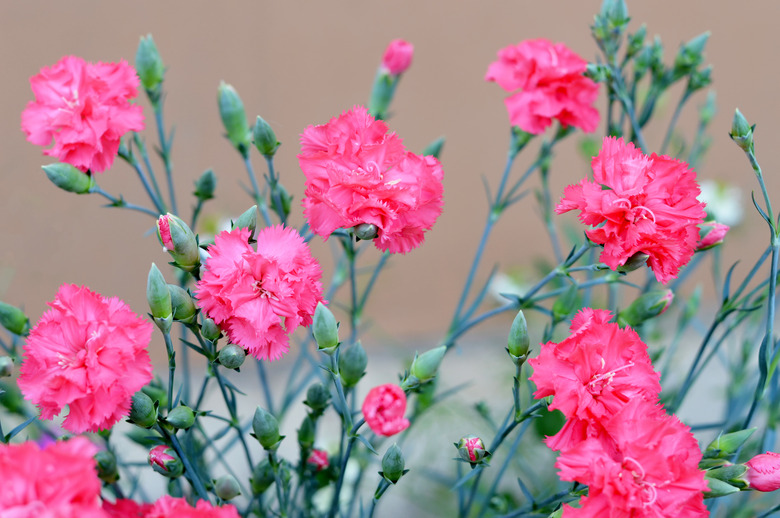Does Dianthus Come Every Year?
We may receive a commission on purchases made from links.
The Dianthus genus, also known as the pink or carnation family, is a large group of spicy-sweet, scented flowering plants that includes annuals, biennials, and perennials. Depending on the species and cultivar, biennial and perennial dianthus are hardy in U.S. Department of Agriculture plant hardiness zones 3 through 10. Biennials and perennials will come back for at least two years, and nearly all the Dianthus species will reseed and produce new plants the following spring.
Tip
The various Dianthus species include annuals, biennials, and perennials. Biennials and perennials will come back for at least a second year, and annuals will reseed into the garden to produce new plants every year.
The Dianthus Species
The Dianthus Species
The Dianthus genus includes approximately 340 species and more than 27,000 named cultivars. Among the best-known species grown in United States gardens are carnations (Dianthus caryophyllus), China pinks (D. chinensis), cottage pinks (D. plumarius), and sweet Williams (D. barbatus). While dianthus are generally cold-hardy plants, a few can also tolerate hot summers.
The various types of carnations thrive in USDA zones 5 through 10 depending on the cultivar. Growing to a height of 12 to 24 inches or more, they produce their ruffled white, yellow, pink, red, or variegated blossoms in midsummer. The hardy border carnations thrive in the cooler climates of USDA zones 5 through 8, while the taller, large-flowered hybrids grown for bouquets are not as cold-tolerant, preferring USDA zones 7 through 10.
China pinks, hardy in USDA zones 7 through 10, grow in 3- to 4-inch-tall mounds with flower stalks rising 6 to 10 inches tall. Both perennial cottage pinks and biennial sweet Williams are hardy in USDA zones 3 through 9. Cottage pinks grow 12 to 15 inches tall and produce clove-scented pink to lavender flowers. Sweet Williams are cluster-headed with multiple flowers on 12- to 24-inch stems.
Dianthus in the Garden
Dianthus in the Garden
Dianthus thrive in full sun and partial or dappled shade. In the hottest regions, give the plants some afternoon shade. Whether in a garden bed, border planting, or rock garden, the soil must be well drained and preferably a neutral pH level of 6.0 to 8.0. Dig in 2 to 4 inches of compost to lighten the soil and provide nutrients to the plants' roots. In rock gardens, construct pockets of amended soil between the larger rocks and plant low-growing Dianthus species, such as alpine pinks (D. alpinus) or Cheddar pinks (D. gratianopolitanus), hardy in USDA zones 3 through 9.
Dianthus Care and Feeding
Dianthus Care and Feeding
Water the dianthus when the soil is dry to a depth of 1 inch, generally providing 1 to 2 inches of water weekly. Mulch with pebbles or a 1- to-2-inch layer of organic mulch so the leaves are not resting on damp soil, which promotes fungal diseases of the foliage. If your soil is poor, side-dress the plants with a shovelful or two of compost or scatter a slow-release flower fertilizer over the soil in early spring according to the package directions. Always water thoroughly after fertilizing.
Monitor dianthus for pests, such as slugs and snails, aphids, and spider mites. Hand pick the slimy pests and dispose of them in a bucket of soapy water. Severe infestations of aphids, spider mites, and other pests can be treated with insecticidal or neem oil sprays.
Put on gloves and sterilize your cutting tools by dipping the blades in rubbing alcohol or Lysol and then deadhead fading flowers to encourage continued bud formation and new flowers. If the plants begin to look ragged or spindly, cut back by a third. At the end of the growing season, you can allow the plants to go to seed. Gather the seeds for spring planting or allow them to naturally scatter in the garden.
Winter Care of Perennials
Winter Care of Perennials
Depending on the species and cultivar, perennial flowering plants often die back when frost hits and then new foliage emerges from the roots when warmer temperatures arrive in spring. If your flowers are marginal in your hardiness zone or an arctic cold event is in the forecast, take time to water thoroughly and then cover the garden with a 4- to 6-inch layer of loose bark or straw mulch.
